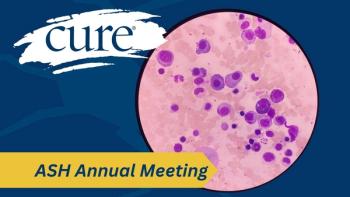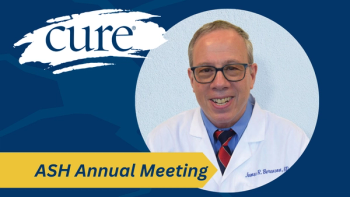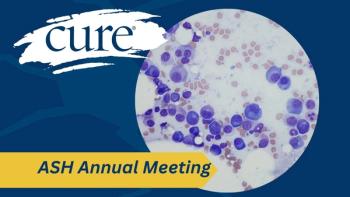
Looking for Answers to Recurrence Years After Surgery
CURE Editor-in-Chief Debu Tripathy, MD, blogs on medical issues from SABCS.
Klaus Pantel, MD, PhD, from the University Medical Center of Hamburg-Eppendorf of Hamburg, Germany, has been a pioneer in the analysis of tumor cells that circulate in the blood and may involve the marrow of patients with breast cancer. In patients who do not have metastases, the presence of microscopic circulating tumor cells does not mean they already have or will automatically experience spread of their disease. However, it does put them at higher risk.
Many questions have arisen from the studies that date back over 10 years. How can some circulating cells remain dormant for years? What turns them on to develop into a true metastasis? Are these cells similar to the main tumor in the breast? Are they more like tumor stem cells that can give rise to a tumor but be resistant to many therapies?
In patients with metastastic breast cancer, the number of circulating cells can be counted with an assay called CellSearch, and this can predict outcome, but it is still not known how to use this information to make treatment decisions. New technology allows these cells to be analyzed more thoroughly, so there is hope that we may understand more how tumors remain dormant, how they evolve over time, and most importantly, how their vulnerabilities that can be targeted therapeutically.
Several studies of older and newer HER2-targeted drugs were also discussed. The use of Herceptin is now standard in HER2-positive early or advanced stage breast cancer. However, in the “neo-adjuvant” setting, where chemotherapy is given before surgery, we know that more patients will have a complete disappearance of their cancer at the time of surgery— but none of the studies went long enough or were large enough to know it would prevent recurrence longer term.
The NOAH study compared chemo alone or with Herceptin and confirmed a higher response rate, but also showed fewer recurrences. At this time, there is no significant difference in mortality. Interestingly, the regimen included Adriamycin with Herceptin, a combination that is contraindicated normally because of the high risk of heart failure—a risk that was noted very early in Herceptin development and before screening and monitoring for heart problems was routine. However, with proper screening and monitoring, the investigators reported very low risk of cardiac problems.
Two newer drugs for HER2-positive cancers were tested in patients who recurred or progressed shortly after or while on Herceptin. One of these, T-DM1, is the Herceptin antibody bound to a very toxic drug so that it is steered directly to the tumor and will not cause damage to other parts of the body. This study showed that nearly half of the patients experienced a response—much higher than is seen with other drugs, like Tykerb, that have been tested in this situation. Very few side effects like low platelet counts and mild eye irritation were seen, but these did not require stopping the drug.
Another drug, HKI -272 (neratinib), was tested in the same situation and also showed promising response rates of 26 percent and as high as 56 percent in patients who had not received Herceptin previously. This drug did cause diarrhea in most patients, and it was moderate to severe in about one third of patients who had received Herceptin before and 13 percent of those who had not.
Both of these drugs will be studied further not only as options for patients who are no longer responding to Herceptin and possibly to Tykerb (which is what is typically used next, in combination with the chemotherapy Xeloda), but also possibly as initial therapy to see which approach leads to best control of cancer with the fewest symptoms. It is also possible that in the future, these drugs will be tested in early stage breast cancer with hopes of even further improving the cure rate over and above what Herceptin can achieve in HER2-positive breast cancer.
The last oral presentation of the day was the first presentation of a study comparing the hormonal therapy Femara alone or in combination with Tykerb in patients with hormonally sensitive advanced breast cancer. The hope was that Tykerb might block signaling pathways associated with resistance to hormonal therapy. Only patients with HER2-positive breast cancer were analyzed (this study enrolled patients regardless of HER2 status), and as expected the addition of Tykerb significantly delayed progression of cancer in the HER2-positive cases.
There was also a hint that it prolonged time to recurrence in patients with HER2-negative cancers that were resistant to tamoxifen. Further follow-up, however, may answer the question of whether Tykerb can “sensitize” tumors to hormonal therapy even if the cells are HER2-negative (read more on Femara and Tykerb here).
For more on HER2 inhibitors from this year's symposium read "New Agents Effectively Target HER2-Positive Cancers" and "Herceptin Before Surgery Highly Effective in Locally Advanced Breast Cancer."
—Published 12.12.08
Fresh Insights Into Hormonal Therapies
The first full day at San Antonio began with discussions about the oldest therapy ever used for breast cancer other than surgery. The demonstration of estrogen’s importance in breast cancer was first noted in 1896 when Sir George Beatson, a Scottish surgeon, noted that removal of the ovaries could make advanced breast cancer regress temporarily. In the 1940s, it was learned that a high dose of estrogen could also be effective as treatment in some cases.
The paradox that estrogen can serve both to fuel breast cancer but at higher doses to treat it is still not fully explained at a scientific level, although hormonally sensitive breast cancer cells can autodestruct at high doses of estrogen. But these high doses can cause symptoms, so a trial of lower doses of estrogen in patients who became resistant to aromatase inhibitors (AIs) was reported by Matthew Ellis, MD, PhD.
He cited data from multiple laboratories suggesting that breast cancer cells that became resistant to estrogen depravation (as seen with aromatase inhibitors) are sensitive to lower doses of estrogen.
Stephen Johnston, MD, PhD, presented the most recent insights on the cellular machinery that leads to hormonal therapy resistance. This is a big issue, because hormonal therapy is among the most effective and with the fewest side effects, so finding ways to “re-sensitize” resistance cancer cells would be of great value. Several studies that address this will be presented later at the Symposium.
The morning session was rounded out by the latest on hormonal therapy in the adjuvant early-stage setting. At the turn of this decade, AIs were first shown to be slightly better than tamoxifen in postmenopausal women, but there has continued to be controversy about whether to start with tamoxifen first, then switch to an AI, such as letrozole, or just start with letrozole.
The first study to directly compare these two approaches, the BIG 1-98 study, presented initial data, and this showed that both approaches were equally effective, but there was a slight (non-statistically significant) trend for patients who received letrozole first to do better (either letrozole for 5 years or letrozole for 2 years, then tamoxifen for 3 years) compared to starting with tamoxifen.
However, others in the audience felt that the presenter, Henning Mouridsen, MD, was over-reaching his conclusions that it might be better to start with letrozole. Another study, called the TEAM trial comparing tamoxifen followed by the AI exemestane to exemestane alone also suggested that it might be better to start with AI—so more time will be needed to know the definitive results of this trial (to read more about hormonal therapy, see The Jury Is In).
In the afternoon, the attention turned to the surgical issues, namely, the meaning of microscopic involvement of sentinel lymph nodes. When a sentinel lymph node contains a cluster of tumor cells less than 0.2 mm, this is technically considered negative N0[i+] and is generally not used to change treatment recommendations. Also, the term micrometastasis is used to describe nodal involvement of 0.2-2 mm range, which technically makes the node stage positive N1[mic].
A large Dutch study of 1744 patients with completely node negative as well as N0[i+] and N1[mic], however, showed that there was more recurrence with both of the N0[i+] and N1[mic], groups compared to the node-negative group, and that these groups also benefited from either hormonal therapy or chemotherapy. This study goes against earlier studies that showed that the N1[mic] group had the same outlook as truly node-negative cases and may force us to rethink how we make decisions in this group. However, larger randomized studies of sentinel node dissection will be available to confirm or reject this registry study (for more on sentinel node dissection read "The Implications of Micrometastases.")
—Published 12.11.08
New Approaches Explored at San Antonio Breast Cancer Symposium
The 31st Annual San Antonio Breast Cancer Symposium opened today with a new pre-conference educational session that underlines the theme of this Symposium—multi-disciplinary and translational issues that address the spectrum from research to practice and from breast cancer prevention to treatment of advanced disease.
This is the first year that the American Association of Cancer Research has partnered in putting on the symposium(other partners are the Cancer Therapy and Research Center at the University of Texas Health Science Center at San Antonio and the Baylor College of Medicine). This new partnership will probably create a new flavor—infusing more basic science while preserving interaction between basic scientists and clinicians. Of course, this makes sense since the last decade has brought the clinic and the laboratory closer together.
Does
how
What this means to patients is that new findings in the lab turn into better diagnostic tests and treatments more quickly. The day’s speakers included José Baselga, MD, from Vall d’Hebron University Hospital in Barcelona, Spain, who embodies the translational scientist, and he has developed a series of clinical trials where the questions asked are more than “ the new drug shrink the tumor?”, but rather does the drug work at the cellular level, how might we make it better, and for what tumor subtype will this drug really be effective.This is done through sophisticated studies of tissue and sometimes newer imaging techniques that provide a more complete picture of the drug’s activity.
Presentations of examples of newer targeted drugs using this research model do suggest that we can learn faster with fewer patients in the early trials, and also weed out drugs or combinations that might not be that promising before they enter large-scale trials with hundreds of patients.
Douglas Yee, MD, followed Baselga with a presentation about the theory behind attacking another receptor that is a cousin of the HER2 receptor, the insulin-like growth factor receptor (IGF-1R).While this receptor has been studied for decades in breast cancer, we now know that this receptor interacts with growth pathways in breast cancer.Several drugs that block IGR-1R are entering clinical trials and will probably go through the types of “correlative” studies described earlier (read more on Dr. Yee and his studies of IGFRs here).
Carlos Arteaga, MD, amplified more on the signaling networks that cause cells to grow and how mutations and other alterations in cancer that affect these networks remain necessary over the course of the disease.This is good news, because it tells us that a firm understanding of genetic lesions that initiate cancers can still be attacked even as the cancer matures and develops additional mutations.
Anthony Letai, MD, discussed new generations of drugs that augment the natural tendency of aging and damaged cells to die through a process called apoptosis.It turns out that cancer cells have figured out ways to evade apoptosis even though the triggering events, such as radiation, cancer drugs, genetic mutations, and other signs of danger are present.Several “pro-apoptotic” drugs are now entering clinical trials although the first generation of these agents were somewhat disappointing in early phase clinical studies.There are more targeted drugs than ever before that address the many cancer-causing pathways.We can get clues as to which drugs and combinations will be the most successful in the clinic through newer tools in the laboratory, but ultimately, we have to understand the effectiveness and safety by designing human trials and hoping that we put the best agents forward based on lab studies.
U.S.
Canada
Asia
As trials become more complex, we have to use more elegant statistical tools—for example, to make some sense of the data that comes from measuring thousands of genes in the tumors of 20 patients before and after an experimental drug.We must also organize trials that are larger and designed to look at specific patient subsets so that they can be completed more quickly and be more informative.This has required extensions of clinical trial networks in the , , and Europe, and now expanding to Latin America, Eastern Europe, and .Susan Hilsenbeck, PhD, and Martine Piccart, MD, PhD, described the challenges and potential rewards of changes in trial networks, designs, conduct, analysis, and interpretation.The research community, governments, and private companies are beginning to invest in this structure, a critical element for success that is now under threat in today’s turbulent economic atmosphere.
meeting
San Antonio
All this material was packed into a two-hour session, just one sign of the fast-paced days that lie ahead in what I believe to be the biggest and most influential breast cancer in the world.Stay tuned for daily progress and insights from as this year’s story unfolds.
—Published 12.10.08
Read more of CURE's coverage of the 31st annual San Antonio Breast Cancer Symposium at http://media.curetoday.com/htmlemail/sabcs.
One of the morning lectures delved into the question of why some patients can develop recurrence or spread of cancer many years after surgery. One of the clues might be circulating tumor cells that can remain “dormant for many years.”





